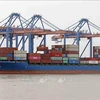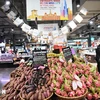Vietnam has secured its place as the world’s top cashew exporter for eight consecutive years, supplying roughly 60 percent of the cashew nuts in the global markets.
According to the Ministry of Industry and Trade, the sector pocketed 276 million USD in revenue during the first two months of 2015, posting an annual increase of 44.7 percent.
Last year, as many as 1.2 million tonnes of cashew nuts were shipped abroad, generating nearly 2 billion USD and representing the largest figure recorded so far, according to the Vietnam Cashew Association (Vinacas).
The internationally recognised Vietnamese cashew is now sold in 50 countries, with 30 percent of total exports destined for the US and the remaining for China , the Netherlands , India , Germany , Japan , and others.
Cashew nuts have become one of the key export staples of Vietnam ’s farming sector, following rice, rubber and coffee.
Despite challenges in 2015, such as the Euro devaluation and the oil crisis, the cashew market remains relatively stable due to increasing demand, the Vinacas commented, saying this is a good opportunity for businesses to expand the market.
However, a number of issues require additional attention, such as narrowed growing areas, according to Vinacas Chairman Nguyen Duc Thanh.
He noted that the country harvests about 400,000 tonnes of raw cashew nuts per year, but the plants are capable of processing up to 1 million tonnes of cashew. Around 50 percent of raw cashew nuts are imported, mainly from Africa , to serve as material supply for processing and exports.
He recommended developing land area for growing cashews, creating high-yield products, and building a production and sales chain.
Businesses are also encouraged to forge links with foreign cashew growers, such as those in Cambodia and Laos , to form a stable material area in close proximity to Vietnam to reduce the cost of material import.
They are also urged to keep close check on imported materials to protect the Vietnamese cashew brand and reputation.
The sector targets 2.5 billion USD in export revenue in 2015.-VNA
According to the Ministry of Industry and Trade, the sector pocketed 276 million USD in revenue during the first two months of 2015, posting an annual increase of 44.7 percent.
Last year, as many as 1.2 million tonnes of cashew nuts were shipped abroad, generating nearly 2 billion USD and representing the largest figure recorded so far, according to the Vietnam Cashew Association (Vinacas).
The internationally recognised Vietnamese cashew is now sold in 50 countries, with 30 percent of total exports destined for the US and the remaining for China , the Netherlands , India , Germany , Japan , and others.
Cashew nuts have become one of the key export staples of Vietnam ’s farming sector, following rice, rubber and coffee.
Despite challenges in 2015, such as the Euro devaluation and the oil crisis, the cashew market remains relatively stable due to increasing demand, the Vinacas commented, saying this is a good opportunity for businesses to expand the market.
However, a number of issues require additional attention, such as narrowed growing areas, according to Vinacas Chairman Nguyen Duc Thanh.
He noted that the country harvests about 400,000 tonnes of raw cashew nuts per year, but the plants are capable of processing up to 1 million tonnes of cashew. Around 50 percent of raw cashew nuts are imported, mainly from Africa , to serve as material supply for processing and exports.
He recommended developing land area for growing cashews, creating high-yield products, and building a production and sales chain.
Businesses are also encouraged to forge links with foreign cashew growers, such as those in Cambodia and Laos , to form a stable material area in close proximity to Vietnam to reduce the cost of material import.
They are also urged to keep close check on imported materials to protect the Vietnamese cashew brand and reputation.
The sector targets 2.5 billion USD in export revenue in 2015.-VNA



















